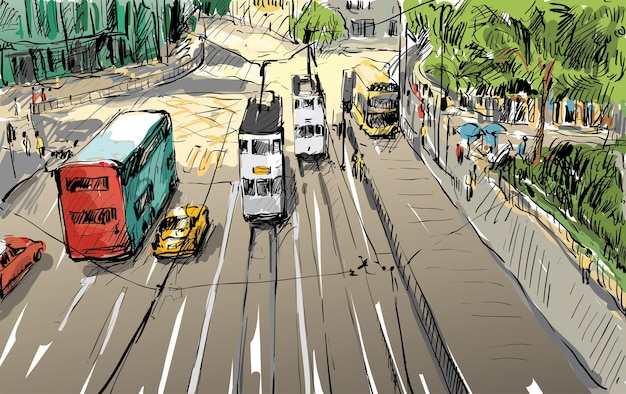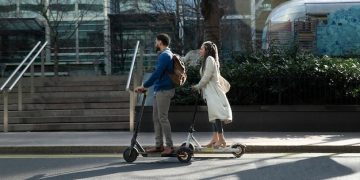Universal Basic Mobility in US Cities: Challenges and Opportunities

Universal Basic Mobility (UBM) programs in US cities face challenges such as funding and equity concerns, but offer opportunities to improve accessibility, reduce congestion, and promote economic growth by ensuring all residents can access essential services and opportunities.
The concept of Universal Basic Mobility (UBM) is gaining traction in urban planning circles across the United States. But, what are the real-world hurdles and potential benefits when US cities try to put UBM into action?
Understanding Universal Basic Mobility (UBM)
Universal Basic Mobility (UBM) aims to provide all residents with access to essential transportation options, regardless of income or location. This concept goes beyond traditional public transit, encompassing a range of services and infrastructure designed to ensure everyone can reach jobs, healthcare, education, and other necessities.
Core Principles of UBM
UBM is rooted in several key principles that guide its implementation. These principles ensure that mobility solutions are equitable, sustainable, and responsive to the needs of the community.
- Equity: Ensuring equal access to transportation resources for all residents, especially those in underserved communities.
- Accessibility: Providing convenient and affordable transportation options that connect people to essential services and opportunities.
- Sustainability: Promoting environmentally friendly modes of transportation and reducing reliance on private vehicles.
- Efficiency: Optimizing transportation networks to minimize congestion, travel times, and overall costs.
By focusing on these core principles, UBM aims to create more livable, equitable, and sustainable cities where everyone can thrive.
Key Challenges in Implementing UBM
While the vision of UBM is compelling, implementing it in US cities presents significant challenges. These challenges range from financial constraints and infrastructure limitations to equity concerns and public perception.

Funding and Financial Sustainability
One of the most significant hurdles is securing adequate funding for UBM programs. Traditional funding models often rely on fares and taxes, which may not be sufficient to cover the costs of providing comprehensive mobility services.
Exploring innovative financing mechanisms, such as public-private partnerships and value capture strategies, is essential to ensure the long-term financial sustainability of UBM initiatives.
Infrastructure Limitations
Many US cities lack the necessary infrastructure to support UBM. This includes inadequate public transit systems, limited bicycle lanes, and a lack of pedestrian-friendly infrastructure.
Investing in infrastructure improvements is crucial to creating a seamless and integrated mobility network that meets the needs of all residents.
Opportunities Presented by UBM
Despite the challenges, UBM presents numerous opportunities for US cities. By embracing innovative approaches and prioritizing equitable outcomes, cities can leverage UBM to enhance accessibility, reduce congestion, and promote economic growth.
Enhanced Accessibility
UBM can significantly enhance accessibility for residents, particularly those who are low-income, elderly, or disabled. By providing affordable and convenient transportation options, UBM can connect people to jobs, healthcare, education, and other essential services.
This is particularly important in cities where transportation options are limited and reliance on private vehicles is high.
Reduced Congestion
By promoting the use of public transit, cycling, and walking, UBM can help reduce traffic congestion and improve air quality. This can lead to significant environmental and health benefits for urban residents.
Implementing UBM requires a shift away from car-centric planning and towards a more sustainable and multimodal transportation system.

Equity Considerations in UBM
Equity is a central consideration in the implementation of UBM. Ensuring that UBM programs benefit all residents, regardless of income, race, or location, is essential to creating a more just and equitable urban environment.
Addressing Transportation Deserts
Transportation deserts, areas with limited access to transportation options, disproportionately affect low-income and minority communities. UBM can help address this issue by providing targeted investments in these areas.
This can include expanding public transit service, building new bicycle lanes, and improving pedestrian infrastructure.
Affordability
Affordability is another key equity consideration. UBM programs must be designed to ensure that transportation options are affordable for all residents, regardless of their income.
This can include offering discounted fares for low-income riders and implementing innovative pricing strategies.
Technological Innovations Supporting UBM
Technological innovations are playing an increasingly important role in supporting UBM. From smart transit systems to ride-sharing platforms, technology can help improve the efficiency, accessibility, and sustainability of urban mobility.
Smart Transit Systems
Smart transit systems use technology to optimize transit operations and improve the rider experience. This can include real-time tracking of buses and trains, mobile ticketing, and integrated trip planning tools.
These systems can help make public transit more convenient and attractive, encouraging more people to use it.
Ride-Sharing Platforms
Ride-sharing platforms, such as Uber and Lyft, can also play a role in UBM. By providing on-demand transportation services, these platforms can help fill gaps in the transportation network and connect people to essential services.
However, it is important to regulate ride-sharing platforms to ensure that they operate in a fair and equitable manner.
Policy and Governance Frameworks for UBM
Effective policy and governance frameworks are essential for the successful implementation of UBM. These frameworks should provide a clear vision for UBM, establish measurable goals, and ensure accountability.
Cross-Sector Collaboration
UBM requires collaboration across multiple sectors, including transportation, housing, health, and education. By working together, these sectors can develop integrated solutions that address the complex challenges of urban mobility.
Community Engagement
Community engagement is also crucial. UBM programs should be developed in consultation with residents to ensure that they meet the needs of the community.
This can include holding public meetings, conducting surveys, and establishing community advisory boards.
| Key Point | Brief Description |
|---|---|
| 💰 Funding Challenges | Securing sustainable financing for UBM programs is a major hurdle. |
| 🚌 Accessibility Improvement | UBM enhances access to jobs, healthcare, and education for all residents. |
| 🌍 Sustainability Goals | UBM promotes eco-friendly transport, reducing congestion and pollution. |
| 🤝 Community Engagement | Involving residents ensures UBM programs meet community needs effectively. |
FAQ
▼
UBM is a transportation system guaranteeing essential mobility options for all residents, regardless of income or location. This includes public transit, walking, biking, and shared mobility services.
▼
UBM improves accessibility, reduces congestion, promotes economic growth, and enhances quality of life for all residents, making cities more equitable and sustainable.
▼
Key challenges include securing adequate funding, addressing infrastructure limitations, ensuring equity, and overcoming public perception challenges.
▼
Smart transit systems, ride-sharing platforms, and data analytics can optimize transportation networks, improve accessibility, and enhance the user experience for UBM programs.
▼
Effective policies and governance frameworks are essential, providing a clear vision, establishing measurable goals, and ensuring collaboration across sectors and community engagement.
Conclusion
Implementing Universal Basic Mobility (UBM) in US cities presents both significant challenges and exciting opportunities. By addressing funding constraints, infrastructure limitations, and equity concerns, cities can leverage UBM to create more accessible, sustainable, and equitable urban environments for all residents.





